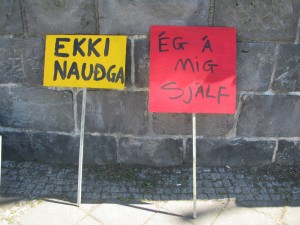Is this person a drusla, a slut? Posted by hulda on Jun 24, 2012 in Icelandic culture, Icelandic customs
You may be wondering why on earth am I so keen on teaching you rude words of Icelandic today with such a provocative image attached, but I have an excuse, I swear! The annual Drusluganga (SlutWalk) parade crowded up the downtown area yesterday and by a lucky accident I happened to walk right into it. The answer to the question in the title naturally is: no, and you should never assume that just by the clothes, even outside of a Drusluganga.
However, this gives me a perfect opportunity for a short lesson on spoken Icelandic. Icelandic has many unusual pronunciation rules and the word drusla (= rag, slut) includes an important one that’s called d-innskot (= insertion of a “d”, although in Icelandic it’s pronounced so sharply it’s actually closer to a “t”).
When a word has a combination of consonants r+l, r+n, s+l or s+n, it gets a silent d/t between those consonants. In other words you make every motion you would to add that letter there but in the end you don’t actually voice it out, just leave a t-shaped silence in its stead. Ok, that was perhaps a little bit too confusing – it may be an easier rule to pronounce that extra letter there anyway, that makes it easier for Icelanders than if you were to not pronounce any extra letters at all.
“Don’t rape” and “I own myself”.
Reykjavík downtown area is so tiny that if you’re just within it you won’t miss a parade no matter what you do and that’s exactly what happened to me. A) Icelanders are loud. Rumour goes that they’re louder than most Europeans by default and I don’t doubt it. B) The processions almost always take the same route, beginning by Hallgrímskirkja where everyone gathers and then moves down Skólavörðustígur to assemble again somewhere past Lækjargata. Three most common places for a process to end are Ingólfstorg, Austurvöllur and Lækjartorg.
The idea of SlutWalk may seem a little unusual for a country where nudity is tolerated to a point where the limit is drawn to a sense of a proper situation instead of any personal moral ground. To an Icelander there are times and places where public nudity is completely acceptable, even compulsory, and it’s not considered f.ex. harmful to children if they happen to see naked people. Such a place is any swimming hall you find in Iceland: if you go in please be prepared to not only see the locals run around the changing rooms and showers with nothing on, you yourself will also be expected to do the same.
It also needs to be pointed out that Icelandic ladies wear rather skimpy outfits in general and that it’s not usually considered “slutty”. Certainly the “she was dressed like she wanted it” -excuse will not work here. Icelanders are practical rather than prudish and while they’re just as happy as anyone to make fun of the skinka (= ham)*, girls who go overboard with make-up, bleached hair, fake tan and tiny clothes, telling someone what they can or cannot wear seems rather unthinkable. This is, after all, the country of Silvía Night, Björk and Páll Oskar and chances are that no matter how extraordinary your clothes are the locals have seen that before, and more.
“Don’t let rape yourself.”
SlutWalks around the world tend to adapt to their surroundings and Iceland is no exception. Over here the main focus of the walk is the way rapes get often blamed on the victim in some way, no matter which way it is. Excuses exist everywhere I’m afraid, even in countries where some of the elsewhere common ones would sound ridiculous. This can also be seen in the actual parade itself where there were few people in less-than-normally small clothes and no (female) nipples out. It’s simply not the biggest point over here that women should be allowed to wear what they want and not be held partially guilty if someone attacks them, Icelanders already got that one. What they want to get through is that no excuse whatsoever can ever shift the blame on the victim.
Let’s take a look at the parade!
*The male counterpart is called hnakki, a neck. A quick Google image search will help you identify both types.

Build vocabulary, practice pronunciation, and more with Transparent Language Online. Available anytime, anywhere, on any device.
About the Author: hulda
Hi, I'm Hulda, originally Finnish but now living in the suburbs of Reykjavík. I'm here to help you in any way I can if you're considering learning Icelandic. Nice to meet you!






